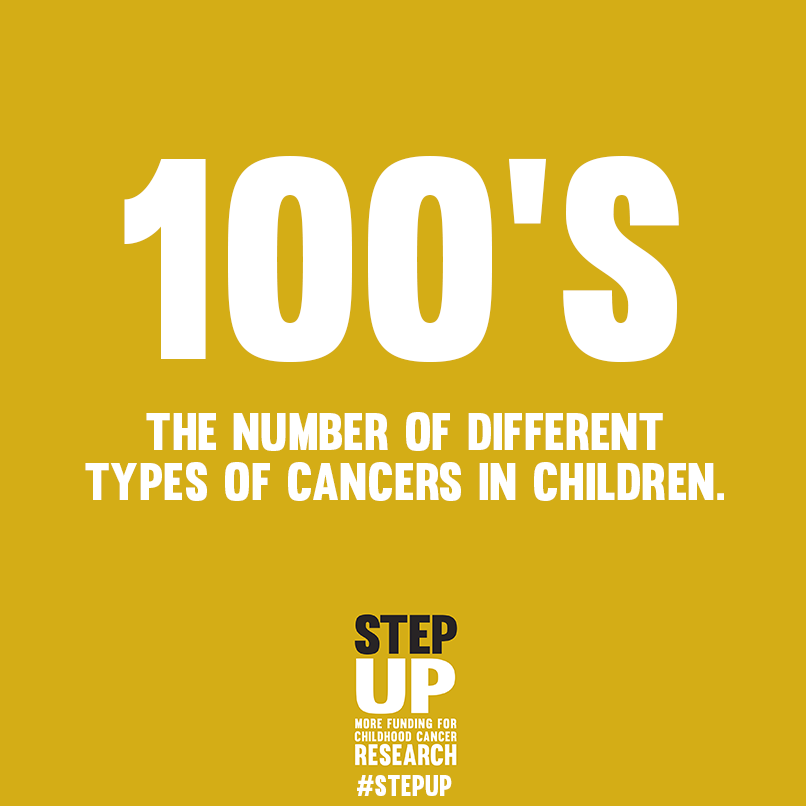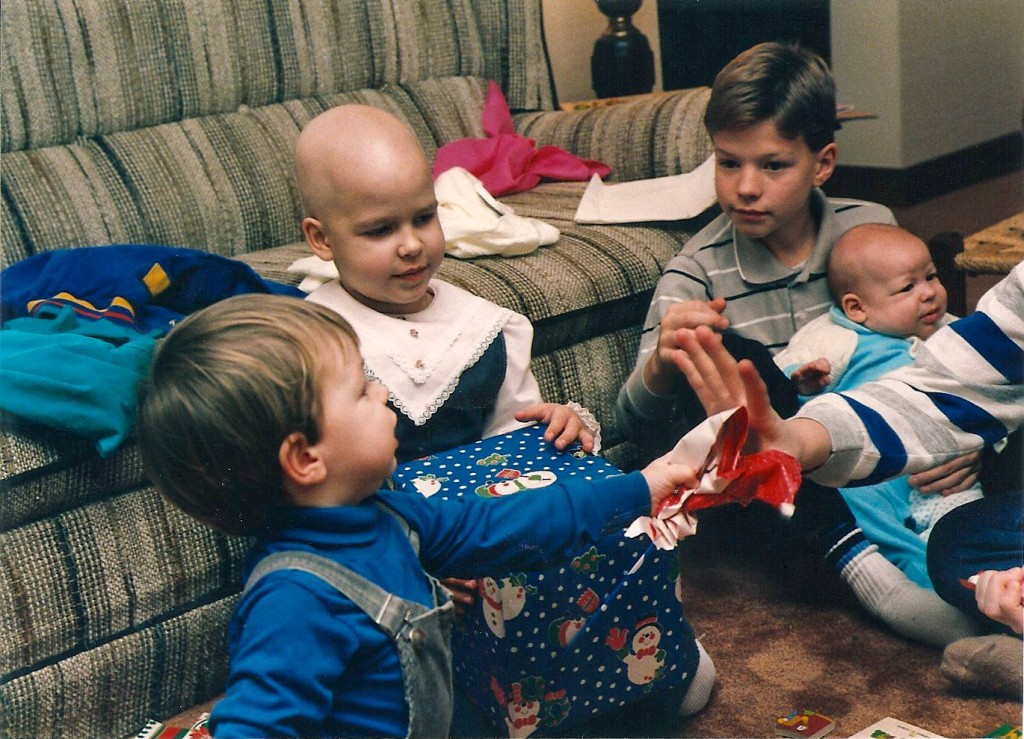100’s – The Number of Different Types of Cancers in Children #StepUp #SoundOff

It is a parent’s worst nightmare: taking your child to specialist after specialist to diagnose the strange symptoms he or she is experiencing, only to hear the doctor utter those dreaded words “your child has cancer.” As the days, weeks, and months continue on, you find yourself mired in an entirely new and unfamiliar lexicon; words you thought you knew take on an entirely different meaning even as you begin learn a whole new vocabulary. Because “childhood cancer” isn’t as simple as it sounds. In fact, there are literally hundreds of different forms of childhood cancer, and each child’s specific treatment and chances of long-term survival depend on exactly what type of cancer he has developed, where the cancer is, and how readily it is accessible to treatment. Listen to one mother’s experience as she begins to navigate the vast and difficult world of “childhood cancer”:
My daughter was 7 years old when she was diagnosed with acute myelogenous leukemia (AML). I remember writing those words down on a piece of paper and placing it on my fridge. I thought I knew what “leukemia” was, when in truth I had no idea how long it would take for me to memorize those words and understand just what they would mean for my precious little girl. I knew what acute meant. I knew that leukemia was a blood cancer but what did myelogenous mean? What was “acute myelogenous leukemia”, and who would help me understand the significance of those three words put together? The answers to these questions and the way in which they came to me were completely unexpected. The little girl in the next hospital room had been diagnosed just a few days earlier with a different type of leukemia―acute lymphoblastic leukemia (ALL). Her family taught me that my daughter’s diagnosis was different from their daughter’s. They said how sorry they were that my daughter had been diagnosed with the “bad leukemia.” All I could think was, how any childhood cancer could be considered “good.” Isn’t all cancer bad? Especially when it happens to children?
 Over time I learned that not only was my daughter’s leukemia different from her hospital friend’s, but that there are seven different subtypes of acute myelogenous leukemia, as well as multiple different subtypes of acute lymphoblastic leukemia. I learned that after “leukemia”, “brain tumors” are the second most-common form of childhood cancer, but each brain tumor is different. I learned that children can have cancer in their eyes, their bones, their muscles, and their liver, or their cancer can arise from the adrenal gland, the lymph nodes, or body’s soft tissues. I also learned that children are NOT diagnosed with the forms of adult cancer we hear most about and receive the most attention―breast, lung, colon, and prostate cancer. I had always believed that children aren’t ‘little adults,’ but this couldn’t have been truer when comparing the types of cancer that adults are diagnosed with to the hundreds of different types of cancer diagnosed in our nation’s littlest cancer patients.
Over time I learned that not only was my daughter’s leukemia different from her hospital friend’s, but that there are seven different subtypes of acute myelogenous leukemia, as well as multiple different subtypes of acute lymphoblastic leukemia. I learned that after “leukemia”, “brain tumors” are the second most-common form of childhood cancer, but each brain tumor is different. I learned that children can have cancer in their eyes, their bones, their muscles, and their liver, or their cancer can arise from the adrenal gland, the lymph nodes, or body’s soft tissues. I also learned that children are NOT diagnosed with the forms of adult cancer we hear most about and receive the most attention―breast, lung, colon, and prostate cancer. I had always believed that children aren’t ‘little adults,’ but this couldn’t have been truer when comparing the types of cancer that adults are diagnosed with to the hundreds of different types of cancer diagnosed in our nation’s littlest cancer patients.
In spite of both girls having “leukemia”, I learned that their diseases were in fact very different, and thus their treatments were very different as well. My daughter went on to have a bone marrow transplant. Her treatment was completed within one year of her diagnosis, but she was subsequently diagnosed with a secondary cancer stemming directly from the treatment that she received to fight her AML (M5). Undergoing the AML treatment when her body was young and still developing also caused endocrine dysfunction, heart and lung damage, and other serious late effects, forcing her to make serious lifestyle decisions. The other little girl’s treatments for ALL lasted almost three years, and resulted in extensive hearing loss, cognitive deficits, obesity, and alienation. Two girls, two types of leukemia, two different treatments. Both survivors, both paying a huge price for that survival.
As this mother found out, it’s not enough to learn that your child has “leukemia” or a “brain tumor”. To ensure your child’s greatest chances of long-term survival, it is critical to know exactly what type of leukemia or brain tumor is involved. When we refer to “childhood cancer”, we are actually referring to more than 100 different cancers. Physicians and researchers broadly group “childhood cancers” into 10 main categories, such as leukemia, brain tumors, sarcomas, bone cancers, and lymphomas, to name just a few. These broad categories are then broken down into specific types and from there into subtypes, depending on where in the body the cancer developed and the type of cells the cancer developed from. For instance, there are nine main classifications of brain tumors, each of which is then broken down still further into a wide range of subtypes. There are two main kinds of bone cancers—osteosarcoma and Ewing’s Family of Tumors—but four types of soft-tissue sarcomas. Imagine how overwhelming it must be for a parent whose child has been newly-diagnosed with “cancer” to navigate through the technical discussions with physicians and specialists, while still trying to come to grips with just the basic facts.
While all childhood cancers tend to be more aggressive than many adult cancers, specific long-term survival rates vary widely within each subtype grouping. Take two different forms of “brain tumors”, for instance. Medulloblastomas, which account for the largest percentage of pediatric brain tumors, are very aggressive and highly malignant, and grow quickly; for high-risk patients, survival rates are only around 50-60% (and the percentage drops drastically for infants). Gangliogliomas, on the other hand, are slow-growing and rarely malignant, and thus survival rates are significantly higher, closer to 90%, although treatment often involves serious long-term side effects. And what about the “bad” kind of leukemia? Long-term survival rates for AML are only around 45-60%, while the most recent studies have shown that ALL has a survival rate of closer to 90%.
So perhaps it should come as no surprise that the treatment options for “childhood cancers” are just as varied as the types of cancer and their long-term survival rates, complicating the job of researchers and making the development of appropriate medications unprofitable for pharmaceuticals. But cancer’s smallest victims deserve just as much attention, research, and funding as adults threatened by adult cancers, and you can help make this a reality. Join us as we Step Up to increase awareness of this inequity and improve funding for childhood cancer research. This is not just another call for donations. This is a call for you to add your voice to the growing chorus: share a post on Facebook and Twitter and enlist a friend or two to do the same. Write a letter to your local congressmen and remind them that they have the power to increase federal funding for childhood cancer research, and the responsibility to use it. Help us give every child, no matter what kind of cancer they are facing, a safe, effective treatment and chance at a full, healthy life: as every child deserves.
You can learn more about Naomi, the girl in the story, at http://hope4acure.net/about
The two videos below share Naomi’s story and the cost of her survival…
There are many ways for you to help:
- A little bird will shout from the rooftops that kids deserve to be a higher priority. Tweet your members of Congress usingSoundOff with a new message each day. Here is an example tweet:
- I just sent a #SoundOff to my Reps in Congress about #StepUp. Would you hit this link and do it too? http://www.soundoffatcongress.org/nY2f
- Posting to Twitter on your own? That’s great! Please use the #StepUp hashtag so we can track our success. Here are some example posts:
- Step Up: More Funding for #ChildhoodCancer Research #StepUp http://www.soundoffatcongress.org/nY2f
- Children with cancer deserve more federal research funding. Tell Congress to #StepUp: http://www.soundoffatcongress.org/nY2f
- Increase appropriations for NCI #StepUp – More Funding for Childhood Cancer Research http://www.soundoffatcongress.org/nY2f
- Help us virtually storm Congress: Ask your Reps to #StepUp & support more funding for childhood cancer research. Please share!
- Email your Representatives (by clicking either of these links: House and Congress) and ask them to increase appropriations for NCI and reauthorize the Carolyn Pryce Walker Act.
- Change your Facebook and Twitter profile photos to the “StepUp” image
- Directly ask three friends to share the message with their representatives


